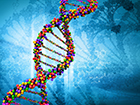Recent Episodes

Most of you probably assume that your genes stay put - that they stay where they started on the chromosome. But that's not always the case. Small pieces of our DNA can relocate and proliferate in other areas of the genome.
They're called retrotransposons or "jumping genes". We don't fully understand their function, but studies suggest they play contradicting roles in normal brain development and neuropsychiatric diseases.
People with Louis-Bar syndrome, a neurological motor disease, have higher levels of a jumping gene called L1. So do people with a form of autism called Rett. And now the same has been found in people with schizophrenia.
A recent study found people with schizophrenia had more of these jumping genes. They're even higher in schizophrenics exposed to certain environments. For example, fetuses with malnutrition are more likely to develop schizophrenia. Nearly half of our genome consists of jumping genes which can be silent, reproduce, or alter the activities of nearby genes. But problems can arise when jumping genes overexpress.
But what causes L1 levels to go up? Could it be environmental factors? To find out, researchers injected pregnant lab rats with a molecule that simulates a viral infection. Indeed those offspring had elevated levels of L1.
In studies with macaques, L1 was also higher in those that were exposed to a hormone that increases the risk of schizophrenia. We can't conclude yet that L1 jumping causes these diseases.
More studies are needed not only to answer this question but to understand how jumping genes might affect our cognitive development.
More Information
'Jumping Genes' Linked to Schizophrenia
"Roaming bits of DNA that can relocate and proliferate throughout the genome, called "jumping genes," may contribute to schizophrenia, a new study suggests."
Barbara McClintock and the discovery of jumping genes
"For much of the 20th century, genes were considered to be stable entities arranged in an orderly linear pattern on chromosomes, like beads on a string. In the late 1940s, Barbara McClintock challenged existing concepts of what genes were capable of when she discovered that some genes could be mobile."
The Jumping Gene: Friend or Foe?
"The color variation in maize comes from transposons, or so-called jumping genes. These stretches of DNA hop out of their original spot in the genome and then wedge themselves in another, random place. When they land, they may disrupt the activities of nearby genes, including pigment genes. The jumping patterns are different in every cell, thus explaining the color variability."

Medicine...
Medicine is constantly advancing – that is a great thing about life in the 21st century. But it doesn’t just happen. Dedicated biomedical scientists are making discoveries that translate into those new medical advances.
Biomedical science is broad, encompassing everything from social science to microbiology, biochemistry, epidemiology, to structural biology and bioinformatics to name just a few areas. And, it can involve basic fundamental biology, the use of AI and chemistry to clinical studies that evaluate new medicines in patients.
No matter the research focus, the goal is always the same, to advance human health. It may take a few months, a few years or for fundamental science, a few decades. Few people make the connection that biomedical science is medicine and that biomedical scientists are working today on the medicine of tomorrow. Our weekly 500-word newspaper columns and 2-minute radio shows and podcasts provide insights into a broad range of biomedical science topics.
Medical Discovery News is dedicated to explaining discoveries in biomedical research and their promise for the future of medicine.





